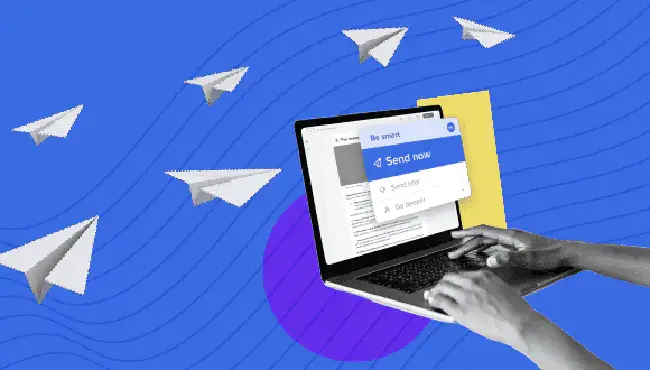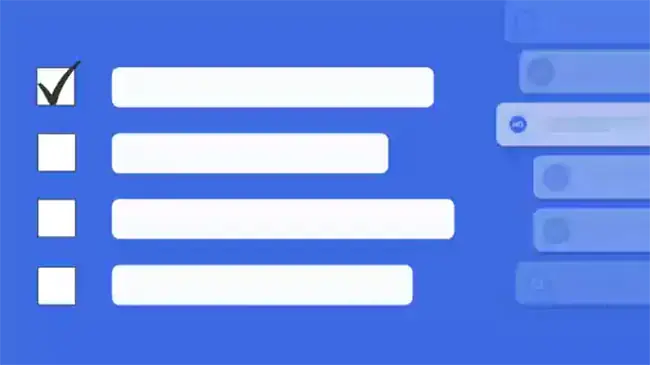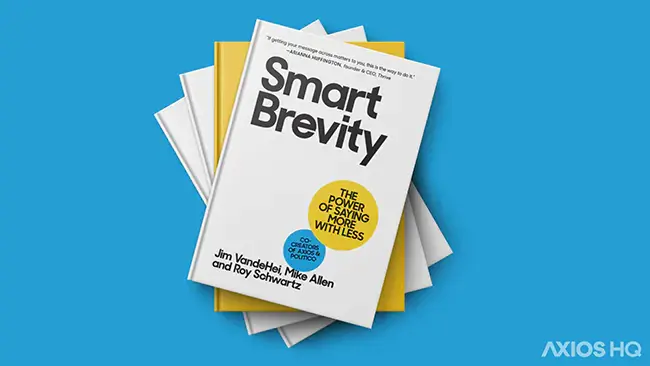10 internal communications ideas leaders can adopt in 2024
More and more, employees are missing out on crucial information due to the sheer volume of communications they receive daily. In fact, 38% of managers and employees report that they receive an excessive volume of communications in their organizations, according to Gartner.
- Why it matters: Effective communication facilitates decision-making, increases employee engagement, and boosts workplace productivity. But you don’t want to create an information overload problem while trying to communicate.
Creating consistent, engaging content in the age of social media and decreased attention spans is challenging but not impossible.
Why effective internal communications matters
Internal communication connects employees and departments through vertical and lateral channels. Effective internal communications through a combination of channels like newsletters, instant messages, and meetings impact business success by improving:
- Employee alignment. Only 14% of workers feel aligned with company goals. Clear communication ensures employees understand your overall business and individual project objectives.
- Employee experience. Communication feedback loops make employees feel valued, increasing engagement and contribution. When employees have positive work experiences, retention rises.
- Work productivity. Organizations with engaged and satisfied workers show higher productivity, reduced absenteeism, and low employee turnover.
- Leadership. Executives who communicate consistently have strong situational awareness and make well-informed decisions.
- Company culture. Workers are brand ambassadors, reflecting your company's core values. Effective internal communication shapes and reinforces positive workplace culture.
- Crisis management. A solid internal communication plan streamlines the flow of information, enabling faster response times to emergencies like data breaches.
The cost of poor communication is high. Harris Poll research shows companies lose $1.2 trillion annually due to ineffective communication practices.
10 internal communication ideas for 2024
Clear communication is vital to a cohesive and productive work environment. These 10 internal communication ideas help make sure you don’t overwhelm employees with confusing, irrelevant, or low-engagment messages.
1. Personalize communications with distribution lists
Effective messaging starts with the right audience. According to a McKinsey report, employees spend 28% of the average workweek reading and writing emails, some of which aren’t relevant to the recipient.
Segmented distribution lists can minimize this productivity sinkhole. Audience segmentation divides your workforce into lists, enabling you to send targeted messages to different groups in your company.
You can segment workers based on:
- Location. Divide employees according to region, facilitating location-specific news and updates.
- Department. Divide employees by business units, facilitating job-specific news and updates.
- Project. Divide workers by projects, facilitating project-specific communication.
- Roles. Divide workers by seniority, facilitating role-specific communication. Employees, board members, senior leaders, and partners receive information relevant to them.
The benefits of segments are:
- Targeted delivery. Ensures the right employees receive pertinent information at the optimal time, eliminating the need to navigate through overcrowded inboxes for crucial communications.
- Saves time. Automated lists reduce the time and effort of adding contacts to lists. You can also set delivery times, allowing for consistent and up-to-date communication.
- Actionable insights. Understanding how different groups respond to internal communication improves decision-making and optimizes internal communication efforts.
The key to building effective distribution lists is understanding what information is pertinent to specific audiences. From there, you can identify the types of emails to send to various employee segments—new hires receive onboarding emails, board members get revenue reports, and so on.
2. Use internal email templates to maintain consistency
Email templates not only save time by eliminating the need to create internal communications from scratch but also promote consistent messaging across your organization, thereby building trust.
You must build consistency in:
- Frequency. The best time to send emails depends on your organization, industry, and location. However, setting a specific day and time to send internal emails ensures employees know when to check for news and updates, increasing engagement.
- Writing style. Develop a communication style guide defining tone of voice and formatting. Make sure to maintain this style across all communications to build trust.
- The purpose of each channel. Employees are more efficient when they know what to expect from various communication channels.
Our library contains communication templates for all-staff updates, shareholder letters, executive briefings, department news, project progress, and more. They utilize Smart Brevity to create concise, scannable communications for maximum engagement.
The framework distills content into two points: what is this about, and why is it relevant?
Here’s a board meeting update before Smart Brevity:
Board of Directors Update
We presented on our progress toward our go-to-market plan in our most recent Board of Directors meeting, Wednesday, including strong product sales over the last quarter within the scope of our beta test, which will allow increased investment in key early growth opportunities across tech and marketing. Plus, with three new manufacturing deals close to closing, Ava’s team is proving their revamped sales pitch was the right move, which sets us up to light our sales pipeline on fire! She got great reactions in the room from the Board.
Back to growth opportunities, we’re updating the second-half roadmap with big investments in the tech team, particularly on the machine learning squad, marketing, to support Ava’s team as they work to capitalize on the early success we’ve seen with the new pitch noted above, and in some exciting new collaborations with firms doing work where we don’t have internal capacity but do have a strategic need to fold missing capabilities into our operations and offering.
This is really exciting stuff, and it’s not only Ava’s team that deserves major credit. We’re seeing historically high sales volumes, and that’s a testament to the whole company. Take a bow, everyone. We were able to “wow” the Board with a report including a 12 percent jump in revenue over the last quarter, which puts us an extraordinary 90 percent of the way to our overall goal for the second half. And that doesn’t include those three pending manufacturing deals. More on those in next week’s update, once we “seal the deal.”
If you haven’t taken time to review Ava’s new sales pitch, we encourage everyone to take a moment to do so. The new talking points went through a lot of pressure testing with focus groups and reflect our best case to date on why our solution is the best in the industry. The materials are available to everyone on the intranet, filed under GLOBAL >> SALES MATERIALS >> PITCH [NEW].
Now, the same message using Smart Brevity.
1 big thing: We wowed our Board
We stunned the Board of Directors Wednesday with our 12% Q3 revenue jump, which puts us 90% to goal for H2.
Why it matters: Higher revenue than ever means we can invest in growth areas that will speed up our go-to-market plan by months.
- New hires: We can now fill key machine learning roles on the tech team and fill out Ava's marketing team, too.
- Partnerships: We'll also finalize priority deals with two firms to expand key capabilities until we can bring them in-house.
How we did it: Testing, testing, testing. Our product speaks for itself, but it was Ava's new sales pitch — pressure tested over three weeks of focus groups — that got it into customers' hands.
What's next: We're closing in on two big manufacturing deals that should put us over the top for revenue goals — look out for more on those in our next update.
The difference is immediately apparent — the first is lengthy with thick text blocks, while the second uses white space and bullet points to focus and guide readers to essential information. The result is a 40% shorter reading time.
3. Build a recurring newsletter
Most employees prefer to receive company updates by email.
A monthly company newsletter is a great way to capitalize on this preference and deliver information without causing email fatigue. By bundling various messages into a single communication, you can avoid spamming employees’ inboxes with separate emails.
Newsletters can cover topics like:
- Industry news
- Policy updates
- Company milestones
- Upcoming events
- Employee or partner stories
- Job postings
- Employee birthdays
Internal newsletters help minimize email clutter, ensuring employees don't miss critical emails from clients or partners. Employees can also access past issues at their convenience on the company intranet.
4. Add rich media to your internal communications
Visual content is the future of communications, including internal messages. Many employees skim internal communication, so your internal communications team must supplement the information they don’t read with high-quality visuals.
Incorporating multimedia elements turns static emails into dynamic communication by grabbing readers’ attention and increasing engagement.
- Use images to show people what you’re talking about.
- Use infographics to represent complex data in easy-to-understand visual formats.
- Use GIFs (animated images) to add visual interest to communication.
- Use videos to condense lengthy information into accessible resources.
- Use Interactive elements like quizzes, polls, and games to collect data.
Video is one of the best internal communication ideas for re-empowering employees. If a picture is worth a thousand words, then a one-minute video is worth 1.8 million. It is the most popular digital format, reaching 92.3% of internet audiences.
Video content can help enhance communication streams like:
- New hire onboarding
- Product demonstrations or tutorials
- CEO message or presentation
- Company announcements
- Employee features
Videos also increase information absorption and reduce language barriers.
5. Encourage peer-to-peer communications
Peer-to-peer communication has a powerful and productive influence on employees. It supports collaboration, knowledge sharing, and positive work experiences, increasing productivity and business performance.
Here’s how to facilitate horizontal communication:
- Add employee profiles to your company intranet. A McKinsey report reveals people spend 20% of the workweek looking for internal information or colleagues to assist them with tasks. Prevent that by including pictures, job titles, departments, projects, and interests in employee profiles.
- Create a mentorship program. Mentorships accelerate mentees' skills and knowledge development and develop mentors’ leadership skills.
- Select internal influencers to champion the organization. Millennials and Gen Z workers engage with employee-created content more than official communication.
- Implement cross-departmental training. No department is an island. Interdepartmental training fosters a deep understanding of what the company does and how each business unit completes the big picture.
Lateral communication improves your employer brand, promotes creativity, encourages accountability, and creates a feeling of unity.
6. Add gamification to internal communications
Gamification can enhance employee engagement with internal communication. It uses games or game mechanics like challenges, rewards, leaderboards, and point systems to increase employee participation and contribution.
Leverage this game-changing communication idea in learning or training processes. For instance, making onboarding fun and engaging by transforming it into an information treasure hunt enables new hires to learn about their work environment and coworkers quickly.
Asking trivia about the company or adding polls to newsletters is a surefire way to excite employees with upcoming issues.
Before gamifying internal communications:
- Set clear objectives by defining the business goals you want to achieve and the employees you’re targeting.
- Choose appropriate gamification elements according to your goals and audience. For example, quizzes increase knowledge, while challenges foster collaboration.
- Select a platform to implement your gamification strategy. These include apps, emails, newsletters, and social media.
Assess the impact of gamification regularly. Collect feedback about what elements are not working and adjust accordingly.
7. Host virtual town halls
Regular town hall meetings with all staff facilitate two-way communication, creating space for workers to interact with management. It also fosters a sense of community.
The core purpose of town halls is participation. At these meetings, executives share company news, recognize outstanding employees, answer questions, and collect feedback.
The benefits include:
- Increased engagement by fostering a sense of community among workers.
- Improved retention as transparency increases morale and employee experience.
- Enhanced decision-making as open communication facilitates understanding of company decisions and policies.
Virtual conferencing software bridges the gap for companies unable to host in-person town halls, ensuring seamless participation and engagement from any geographic location or time zone.
Take a page from Trade Coffee’s playbook. The company hosts a weekly all-hands meeting to share updates and a biweekly anonymous meeting to answer staff questions.
8. Build a knowledge hub
Internal knowledge hubs enable anytime, anywhere access to crucial business documents.
What knowledge is stored and managed here?
- Company information: annual reports, organizational charts, history
- HR material: employee handbooks, training workbooks, or videos
- Sales & marketing collateral: case studies, branding guidelines, templates
- Media files: press releases, promotional images and videos
- Legal documents: contracts, policies, operating procedure
- And more
Three benefits of knowledge hubs are:
- Improved productivity: With a central repository, workers don’t waste time looking for documents or coworkers to help complete tasks.
- Enhanced information security: Cloud-based storage protects against stolen hardware (laptops or USB sticks), and access management prevents unauthorized access to confidential information.
- Information loss prevention: You don’t lose tacit knowledge when an employee leaves the organization.
Knowledge hubs are non-disruptive forms of internal communication and supplement other internal communication channels like email.
9. Integrate your internal comms tech stack
Different messages are best suited for specific communication platforms, but too many internal communication tools can overwhelm employees.
The average project team member frequently toggles between;
- Email platforms
- Company knowledge hubs
- Instant messaging apps (Slack or Teams)
- Cloud-sharing platforms (Google Drive or Dropbox)
- Project management tools (Asana or Trello).
Integrating your tech stack streamlines communication and workflow, keeping staff focused and informed. It also creates equitable experiences for remote teams and in-office workers.
Communication software like Axios HQ offers integrations with your existing tech stack, such as Slack, Gmail, Outlook, HubSpot, and Salesforce, to ensure maximum visibility across all internal communications.
10. Track communication metrics
You can’t manage what you don’t measure. Employee engagement metrics such as open rates—including email opens, read receipts, and app logins—and click-through rates serve as indicators of the success of your internal communication strategies.
How can internal communicators gauge if readers are truly engaging with their content? Tracking the impact of internal communications requires exploring additional methods, including:
- Heatmaps show how readers interact with content, including revealing click patterns and scrolling behavior. Thus, you know where to place critical information to get the most attention.
- Audience segment statistics analyze how various groups in your organization respond to internal communications. That helps you understand which topics matter to different segments.
- Feedback mechanisms, like polls and employee surveys, offer a straightforward way to learn what resonates with your employees. When you ask readers if the information they read was beneficial, you can identify communication strengths and weaknesses.
Quantitative and qualitative measurements provide a complete picture, allowing you to demonstrate ROI on employee communication and justify using fun internal communications ideas.
The bottom line
How you communicate with employees is as important as what you’re communicating. The status quo doesn't cut it with the new generation of employees. Fresh internal communication ideas, like gamification, lateral communication, and multimedia elements, drive engagement and productivity, especially in millennial and Gen Z workers.
Go deeper: Discover 9 ways to improve your internal communication ideas
Internal communications ideas FAQs
1. How do you make internal communications fun?
To make internal communications more fun and engaging, internal communicators should incorporate visual content to simplify messages, encourage employee-generated content for fresh insights, and use gamification to boost engagement.
2. How do you make communication interactive?
Add interactive formats such as polls, surveys, quizzes, trivia, and webinars to make communication interactive. These powerful tools empower employees to actively engage by showcasing their knowledge, sharing insights, and posing questions.





.webp)












.webp)

















